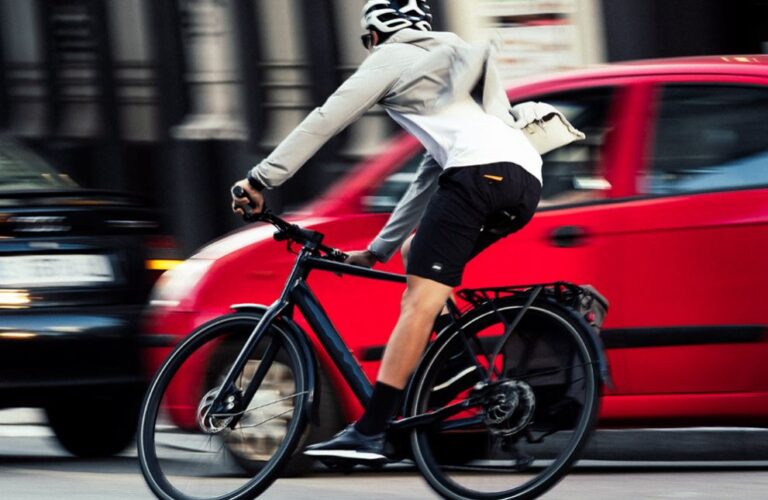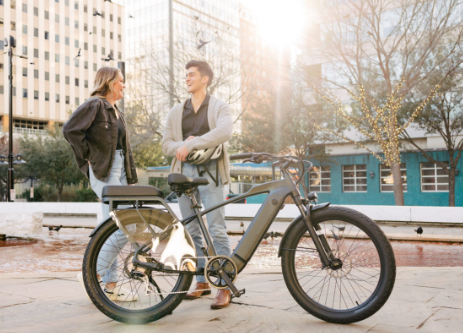Road eBike Buyers Guide

With the rapid technological advancements in the cycling world and an increasing focus on sustainable transportation, electric bicycles, or eBikes, have carved out a significant niche in the market. Lots of my friends ride eBikes and love them. Especially for road users, eBikes represent a fusion of traditional cycling with an added electric boost, ensuring longer rides with less fatigue. However, with the variety of options available, choosing the perfect road eBike can be daunting. This Road eBike Buyers Guide aims to demystify the process and highlight key considerations for potential buyers.
1. Purpose
- Commuting: If you’re using the eBike for daily commutes, prioritize features such as fenders, racks, lights, and a comfortable geometry.
- Touring/Long Rides: Opt for a bike with a larger battery capacity, comfortable saddle, and provision for panniers.
- Casual Riding: For occasional rides, you might not need all the bells and whistles. A basic road eBike with a moderate range might suffice.
2. Motor Location
- Hub Motor: Located in the hub of the rear or front wheel. They’re typically cheaper, quieter, but may not handle hills as efficiently.
- Mid-Drive Motor: Located at the bike’s crank and pedals. They’re more efficient, provide a natural biking feel, and are better for hilly terrains.
3. Battery
- Capacity: Measured in watt-hours (Wh). A higher number indicates a longer range. Depending on the terrain, riding style, and rider’s weight, a 400Wh battery can typically offer 50-100 miles.
- Placement: Some bikes have integrated batteries (within the frame) for a sleek look, while others have external batteries. The choice is aesthetic but can also impact bike weight distribution.
- Removable vs. Fixed: A removable battery is convenient for charging and potential replacement.
4. Range
- Consider how far you plan to ride on a single charge. Remember, factors like terrain, rider weight, and level of motor assistance can impact the actual range.
5. Weight
- eBikes are generally heavier than traditional bikes due to the motor and battery. Ensure you can handle the bike’s weight, especially if you need to carry or transport it.
6. Pedal Assist vs. Throttle
- Pedal Assist: The motor provides assistance only when you pedal. Levels of assistance can often be adjusted.
- Throttle: You can get a boost without pedaling, similar to a scooter. Some eBikes offer both options.
7. Speed
- Most road eBikes are limited to a top assisted speed, often around 20 mph (32 km/h) or 28 mph (45 km/h) for speed pedelecs. Ensure the bike meets local regulations.
8. Frame Material
- Aluminum: Lightweight and resistant to rust. It’s the most common frame material for eBikes.
- Steel: Heavier than aluminum but offers a smoother ride due to its natural vibration-damping properties.
- Carbon Fiber: Lightweight and offers a comfortable ride. Carbon is the way to go if you can afford it.
9. Brakes
- Disc Brakes: Offer consistent performance in various conditions, especially useful for the added weight of an eBike.
- Rim Brakes: Less effective in wet conditions and might wear out rims over time.
10. Price & Warranty
- eBikes can range from a few hundred to several thousand dollars. Determine your budget and check if the manufacturer offers a warranty, especially on the battery and motor.
11. Brand Reputation
- Look for brands with good reviews and a reputation for quality and customer service. Below is a list of the Top eBike Manufacturers
12. Test Ride
- Always a good idea! It helps you gauge the bike’s comfort, power delivery, and handling.
13. Accessories and Extras
- Consider integrated lights, fenders, racks, a comfortable saddle, ergonomic grips, etc., based on your needs.
14. Local Laws
- Some jurisdictions have specific rules about eBike classifications, top speeds, helmet use, etc. Ensure your chosen eBike adheres to local regulations.
15. Maintenance and Repairs
- eBikes have more electronics than traditional bikes. Consider potential repair costs and the availability of spare parts.
Conclusion: In the evolving landscape of urban mobility and leisure cycling, road eBikes emerge as a promising and efficient solution. As with any investment, it’s essential to be well-informed and make a choice that aligns with your personal needs, lifestyle, and budget. By considering the factors laid out in this guide, you’re on the right path to making a decision that you’ll be satisfied with for years to come. Whether you’re riding for the thrill, commute, or the simple joy of being outdoors, a road eBike can enhance the experience, making every journey both enjoyable and sustainable. Safe and happy riding! John
Click Here to see the Best eBikes Reviewed and Rated
FAQ’s
Are eBikes Worth Buying?
The decision to buy an e-bike depends on several factors, including your personal needs, preferences, and the situations in which you intend to use it. Here are some advantages and potential disadvantages of e-bikes to consider:
Advantages:
- Assistance on Hills & Headwinds: E-bikes make climbing hills and cycling against the wind much easier, which can be especially useful in hilly or windy areas.
- Longer Rides: The added boost can help riders travel longer distances without becoming overly fatigued.
- Sweat Reduction: If you’re commuting to work, an e-bike can help you arrive without being sweaty, especially during hot weather or strenuous routes.
- Expand Riding Demographics: E-bikes can make cycling accessible to people who might find traditional bikes too challenging, such as older adults or those with certain disabilities.
- Cost-Efficient Commuting: While the upfront cost of an e-bike can be high, they can save money in the long run by reducing expenses related to gas, parking, and public transportation.
- Environmental Benefits: E-bikes are more eco-friendly than cars and can help reduce traffic congestion in urban areas.
- Enhanced Joy & Recreation: Many riders find the experience of riding an e-bike exhilarating and fun.
Disadvantages:
- Initial Cost: E-bikes generally cost more than traditional bicycles. However, prices have been coming down as technology improves and they become more popular.
- Maintenance: Some e-bike components, like batteries and motors, might need replacement after a few years, adding to the overall cost.
- Weight: E-bikes are heavier than traditional bikes, which can be a challenge if you need to carry or transport them without the aid of electric power.
- Reduced Exercise: While you’ll still get exercise on an e-bike, the assistance might mean you’re expending less energy than on a regular bike.
- Regulations: Some places have restrictions on where e-bikes can be ridden, especially on trails designated for non-motorized use.
- Battery Life: If you’re on a long ride and your battery dies, you’ll be pedaling a heavy bike.
Conclusion:
Whether or not an e-bike is “worth it” will depend on your individual needs and circumstances. If you’re interested in commuting longer distances, want assistance on challenging terrains, or simply want a boost of power during recreational rides, an e-bike might be a great choice. However, if you’re seeking pure exercise or have a tight budget, a traditional bike might be more appropriate.
Before making a decision, it’s beneficial to test ride a few e-bikes to see how they feel, research the laws in your area, and weigh the pros and cons based on your intended use.
Are eBikes with it?
Advantages of eBikes:
- Ease of Travel:
- Assistance on Challenging Terrains: E-bikes make navigating hills, headwinds, and other challenging conditions a breeze, leveling the playing field for riders of varying fitness levels.
- Increased Range: The motor assistance means you can travel farther with the same amount of pedaling effort. This is especially handy for long commutes or exploratory rides.
- Commuting Benefits:
- Cost Efficiency: Over time, eBikes can be more cost-effective than cars or public transport, especially when factoring in expenses like fuel, insurance, and parking.
- Environmental Impact: E-bikes produce zero emissions, making them an eco-friendly transport option, especially in urban settings where vehicle emissions are a concern.
- Avoiding Traffic: In congested areas, an eBike can often get you to your destination faster than a car.
- Inclusivity:
- Accessibility: E-bikes allow individuals who may not have considered cycling due to age, health conditions, or fitness levels to enjoy the benefits of biking.
- Rehabilitation: For those recovering from injuries or surgeries, eBikes can provide a gentle reintroduction to exercise.
- Recreational and Fun Aspect:
- Joy of Riding: Many riders, whether new or experienced, describe the sensation of motor assistance as exhilarating.
- Group Rides: E-bikes allow riders of different abilities to ride together, making group outings more inclusive.
Disadvantages of eBikes:
- Initial and Ongoing Costs:
- Higher Purchase Price: The technology in eBikes, including batteries and motors, make them more expensive than traditional bikes.
- Battery Replacement & Maintenance: Over time, the battery will degrade and need replacement. Some proprietary components can be costly to repair or replace.
- Weight and Portability:
- Heaviness: The added components make eBikes heavier. If you run out of battery in the middle of a ride, pedaling can become strenuous.
- Transportation: Lifting a heavy eBike onto a car rack or carrying it upstairs might be challenging for some.
- Exercise Considerations:
- Reduced Caloric Burn: Because the motor assists with pedaling, you might not get as intense a workout as with a regular bike. This might not be ideal for those using biking primarily for fitness.
- Regulations and Restrictions:
- Varied Laws: Regulations about where and how eBikes can be used vary widely. Some trails or paths may prohibit motorized vehicles, including eBikes.
- Licensing and Age Limits: Some regions might have age requirements or licensing rules for eBike riders.
- Battery Dependence:
- Charging: You need to ensure your eBike is charged before a ride, which requires some foresight and planning.
- Lifespan: Like all batteries, the one in an eBike has a limited lifespan and will eventually need replacement.
In conclusion, the value of an eBike depends on your personal needs, preferences, and the situations in which you intend to use it. If the advantages align with your lifestyle and the disadvantages aren’t deal-breakers, an eBike might be a valuable investment for you.
Are eBikes Getting Cheaper?
E-bikes, like many technology-based products, have seen a gradual reduction in prices over the years due to various factors. Here’s a deeper look into the trends and reasons:
- Economies of Scale: As e-bike popularity has grown, larger production volumes have led to economies of scale. Producing more units typically allows manufacturers to reduce the cost per unit.
- Technological Advancements: Battery and motor technology have improved over the years, leading to more efficient production methods and cost-effective materials. As technologies mature, they tend to become cheaper to produce.
- Market Competition: The increasing number of e-bike manufacturers and brands means more competition. To differentiate themselves or capture a larger market share, some companies might reduce prices or offer more features for a given price point.
- Battery Costs: A significant portion of an e-bike’s cost is tied to its battery. The rise of electric vehicles (EVs) has spurred significant investment and research into battery technologies. As a result, battery prices have been dropping, which has a direct impact on e-bike prices.
- Localization of Production: Initially, many e-bike components, especially batteries and motors, were produced in specific regions, leading to import costs for manufacturers elsewhere. With the growth in the e-bike market, production of these components has become more localized, helping to reduce costs.
- Entry-Level & Budget Options: Recognizing the demand for more affordable e-bikes, some manufacturers have introduced budget or entry-level models with fewer features or lower-tier components, making e-bikes accessible to a broader audience.
However, a few considerations should be noted:
- Quality Variation: While there are cheaper e-bikes available, there’s a vast range in terms of quality. It’s essential to research and possibly test ride before committing to ensure you’re getting a reliable product.
- Potential for Price Increases: External factors such as trade tariffs, supply chain disruptions, or increased demand can lead to temporary price hikes.
- High-End Models: While the entry-level market might see price reductions, high-end e-bikes with advanced features, top-tier components, and new technologies can still be quite expensive.
In conclusion, while e-bikes have generally become more affordable over time, consumers should still do thorough research to find a product that balances cost, quality, and their specific needs.
Can eBikes Get Wet?
Yes, e-bikes can get wet, but there are some important considerations to keep in mind:
- Water Resistance, Not Waterproof: Most e-bikes are designed to be water-resistant, meaning they can handle light rain or splashes. However, this doesn’t mean they are fully waterproof. Extended exposure to heavy rain, submersion, or high-pressure water can be detrimental.
- Electrical Components: The motor, battery, controller, and display are the main areas of concern when it comes to water exposure. Most reputable e-bike manufacturers design these components to be water-resistant to some degree, but it’s always best to consult the owner’s manual or manufacturer guidelines.
- Avoid Deep Puddles: Riding through deep puddles can potentially expose the motor and other components to more water than they are designed to handle.
- Storage: If you’ve ridden your e-bike in the rain, it’s a good idea to store it in a dry place afterward. Prolonged exposure to moisture can lead to problems over time, both with the electrical components and potential rust on the frame or other parts.
- Maintenance After Wet Rides: After riding in wet conditions, it’s wise to wipe down your e-bike to remove excess water and check the chain and other moving parts. Applying some lubricant to the chain and ensuring no water has gotten into sensitive areas can help prolong the life of your e-bike.
- Battery Care: Always make sure the battery compartment is securely closed. If you suspect that water has gotten inside the battery compartment, it’s essential to remove the battery and let everything dry thoroughly before using it again. Charging a wet battery can be dangerous.
- Potential Damage Signs: If your e-bike behaves strangely after exposure to water (e.g., motor glitches, display issues, unexpected power cutoffs), it’s essential to cease riding and consult a professional or the manufacturer.
In summary, while e-bikes can handle some wet conditions, it’s essential to treat them with care and be aware of their limitations. Regular maintenance and checks, especially after wet rides, can help ensure a long and trouble-free life for your e-bike.





